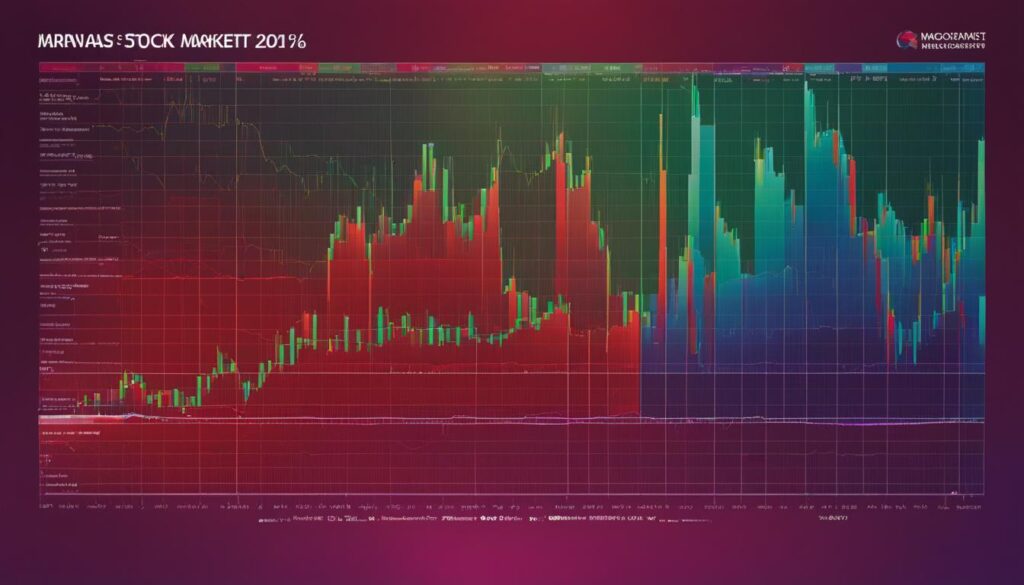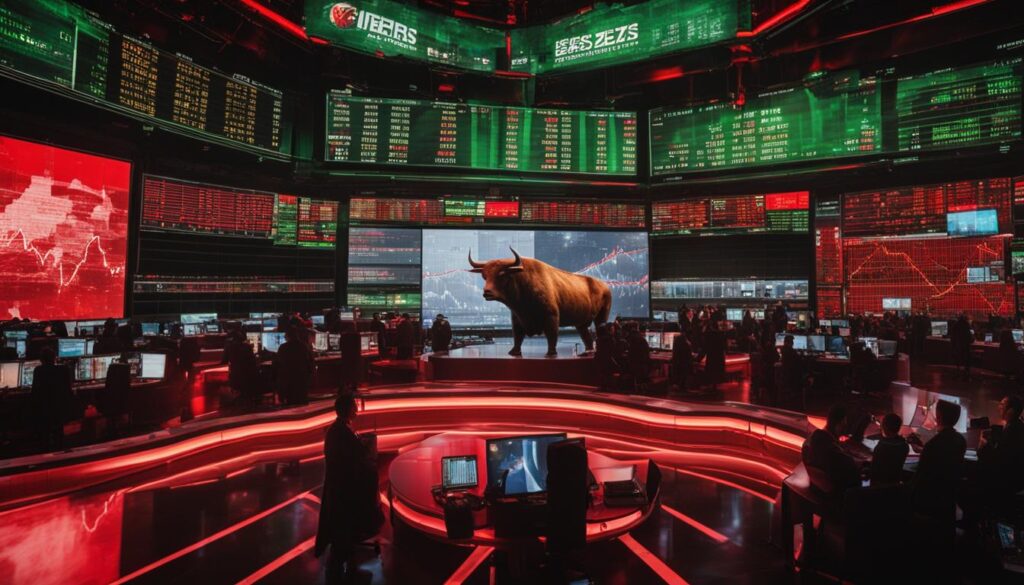Understanding investor behavior is essential for navigating the stock market successfully. In recent years, researchers have delved deep into the realm of stock market psychology, uncovering surprising insights into the emotional aspects of trading, market sentiment, and decision-making. This field, known as behavioral finance, examines how psychological biases can shape investor behavior and influence trading outcomes.
Multiple studies have revealed fascinating findings about stock market psychology. Traders, for instance, tend to be overconfident in their abilities, rating themselves above average and overestimating their professional success. This overconfidence persists even after experiencing losses, as traders are not easily deterred from the market. Chinese investors, in particular, demonstrate trading mistakes and biases, while middle-aged, wealthy, and experienced investors struggle to overcome behavioral biases.
Online traders, exposed to vast amounts of data and the illusion of control, often exhibit heightened overconfidence. Stop loss orders and the psychological appeal of round numbers can influence exchange rates, while technical analysis has proven to outperform other trading strategies in certain cases. Attention-grabbing events and media coverage also play a role in shaping stock prices, with negative words in news stories potentially forecasting low firm earnings.
Investors show a tendency to trade in parallel with their peers, increasing trade size after successful trades. Day traders may exhibit risk-seeking behavior, often seeking investments with negative expected returns but the possibility of significant payoffs.
Key Takeaways:
- Traders often exhibit overconfidence in their abilities and rate themselves above average.
- Chinese investors display trading mistakes and biases, while middle-aged, wealthy, and experienced investors struggle with behavioral biases.
- Online traders are prone to increased overconfidence due to exposure to vast amounts of data.
- Stop loss orders and the appeal of round numbers can influence exchange rates.
- Technical analysis can outperform other trading strategies in certain markets.
Traders’ Overconfidence and Self-Perception
Traders in the stock market often exhibit overconfidence, perceiving themselves to be above average and overestimating their professional success. This overconfidence can lead to detrimental trading decisions and financial losses. Despite experience, traders often struggle with realizing losses, clinging onto losing positions in the hope of a rebound.
Individual investors who perceive their investment skills to be above average tend to trade more frequently, believing they have an edge in the market. However, this overestimation of their abilities can result in impulsive and ill-informed trading decisions.
Overconfidence is not limited to individual traders; even currency dealers demonstrate a propensity to overestimate the precision of their information and their personal competence. This behavior is observed across the spectrum of traders, regardless of their seniority or experience level.
Contrary to expectations, overconfident traders do not exit the market after experiencing losses. In fact, overconfident currency traders continue to participate in the market, risking further losses as they hold onto their inflated self-perception and misguided investment choices.
The impacts of overconfidence are not limited to individual investors. In the foreign exchange market, overconfidence among currency dealers can even affect equilibrium exchange rates, disrupting the entire market’s stability.
Overconfidence is particularly prevalent among Chinese investors, who display various trading mistakes and biases. These include reluctance to realize losses, under-diversification, frequent trading, and a representativeness bias.
Other investor groups that struggle with overcoming behavioral biases include middle-aged, active, wealthy, experienced, and urban investors. These individuals may find it challenging to objectively evaluate their trading decisions, falling victim to their own overconfidence.
Successful online traders often attribute their success to their investment abilities, which further reinforces their overconfidence. This heightened self-perception can lead to increased risk-taking and potentially detrimental trading behavior.
Notable Quotes:
“Overconfidence is a common pitfall among traders, leading to biased decision-making and suboptimal investment outcomes.”
“Overconfidence persists regardless of experience, affecting both seasoned professionals and newer entrants into the market.”
Interesting Insights:
- Traders’ overconfidence can lead to persistent participation in the market despite losses.
- Overconfidence among currency dealers can impact equilibrium exchange rates.
- Chinese investors display various trading mistakes and biases.
- Successful online traders often attribute their success to their investment abilities, leading to increased overconfidence.
Comparing Overconfidence Among Trader Groups
| Trader Group | Overconfidence Level |
|---|---|
| Currency Dealers | High |
| Individual Investors | Moderate |
| Chinese Investors | High |
| Seasoned Traders | Moderate |
Impact of Stop Loss Orders and Round Numbers
Stop loss orders and round numbers play a significant role in shaping exchange rates and market movements. Understanding their impact is crucial for traders and investors seeking to navigate the stock market effectively.
Research reveals that the response of exchange rates to stop-loss orders is more pronounced and enduring compared to take-profit orders. Stop-loss orders can trigger waves of market movements, creating a cascading effect.
Round numbers, such as rates ending in 00, also exert influence on exchange rates. Reversal frequency tends to be higher at round numbers than at arbitrary price levels. Furthermore, exchange rates tend to trend faster after crossing round numbers.
An interesting observation is the clustering of large stop-loss orders near rates ending in 00. However, the same clustering pattern does not occur with very large take-profit orders.
To gain a better understanding of the impact of stop loss orders and round numbers on exchange rates and market movements, let’s refer to the following table:
| Impact Factors | Findings |
|---|---|
| Exchange Rate Response to Stop Loss Orders | Larger and longer-lasting compared to take-profit orders |
| Reversal Frequency at Round Numbers | Greater compared to arbitrary price levels |
| Exchange Rate Trend After Crossing Round Numbers | Faster trend development |
| Clustering of Stop Loss Orders | Near rates ending in 00 |
As seen in the table, stop loss orders and round numbers have a substantial impact on the behavior of exchange rates and market reversals. Traders can leverage this knowledge to make informed decisions and devise effective trading strategies.
Expert Insight:
“Stop loss orders and round numbers hold a powerful influence over market movements. By understanding their impact, traders can capitalize on potential trends and make informed trading decisions.”
Insights on Technical Analysis
Technical analysis is a powerful tool that can significantly enhance trading strategies and generate excess returns in various markets. By incorporating technical analysis into their investment rules, traders can outperform other strategies and achieve substantial trading profits.
One area where technical analysis has shown particularly promising results is in the stock market. When applied to markets like the NASDAQ Composite and Russell 2000, technical analysis has the potential to improve unprofitable trading rules and increase profitability.
One widely used technique in technical analysis is the analysis of moving averages. Moving averages help traders identify trends in the market by smoothing out price fluctuations over a specific period. By analyzing moving averages, traders can make informed decisions about when to buy or sell a particular security.
For example, traders often use the crossover of short-term and long-term moving averages as a signal to buy or sell. When the short-term moving average crosses above the long-term moving average, it is considered a bullish signal, indicating that the price may rise. Conversely, when the short-term moving average crosses below the long-term moving average, it is seen as a bearish signal, suggesting that the price may decline.
Technical analysis can lead to profitable trading strategies and improve unprofitable ones. By incorporating moving averages into their analysis, traders can identify trends and make informed decisions about when to buy or sell.
It is important to note that while technical analysis can be a valuable tool, its effectiveness may vary across different markets and time periods. Research has shown that technical trading profits have gradually declined over time in 12 futures markets, indicating the need for careful analysis and evaluation of trading strategies.
| NASDAQ Composite | Russell 2000 | DJIA | S&P 500 | |
|---|---|---|---|---|
| Technical Analysis | Positive | Positive | Neutral | Positive |
| Other Strategies | Neutral | Negative | Positive | Negative |
Table: Comparison of the Impact of Technical Analysis and Other Strategies on Different Stock Market Indices
As shown in the table above, technical analysis has a positive impact on the NASDAQ Composite and Russell 2000 indices, while other trading strategies may yield neutral or negative results. This highlights the importance of tailoring trading strategies to specific markets and conducting thorough analysis to maximize trading profits.
In conclusion, technical analysis offers valuable insights and trading opportunities for investors in various markets. By leveraging techniques such as moving averages and carefully evaluating their effectiveness, traders can make informed decisions and generate excess returns.

Influence of Big Events and Financial Media
Big events and financial media play a significant role in shaping stock prices and investor behavior. These attention-grabbing events have the power to temporarily impact stock prices, resulting in a temporary rise followed by a reversal to pre-event levels. This volatility in stock prices presents both opportunities and risks for investors.

During big events, such as earnings announcements or major product launches, stock prices can experience significant fluctuations. The media coverage surrounding these events can influence investor sentiment and prompt individual investors to become net buyers of stocks, contributing to the price increase. On the other hand, existing shareholders may take advantage of rising prices during upper price limit events and choose to sell.
The local media also has a strong influence on trading patterns. The presence or absence of local media coverage can affect the probability and magnitude of local trading. Investors tend to react to news stories and headlines, adjusting their investment decisions based on the information provided by the local media.
Negative words in firm-specific news stories can be an indicator of low firm earnings. Investors who closely follow such news stories may take this information into account when making investment decisions. Additionally, investors who have never owned stocks before may be more likely to buy stocks when prices reach their upper limits, influenced by the media hype surrounding these events.
It’s worth noting that extreme weather events can disrupt media coverage and break the relationship between media coverage and trading. When media coverage is affected, the influence of big events on stock prices may be less pronounced.
Impact of Big Events and Financial Media on Stock Prices
To understand the impact of big events and financial media on stock prices, let’s take a look at the following table:
| Event | Price Movement | Investor Behavior |
|---|---|---|
| Earnings Announcement | Temporary rise followed by a reversal | Active individual investors become net buyers |
| Product Launch | Temporary rise followed by a reversal | Existing shareholders may sell at upper price limits |
| Local Media Coverage | Influences probability and magnitude of local trading | Investors react to news stories and headlines |
| Negative Firm-specific News | Forecast of low firm earnings | Investors take news stories into account |
| Inexperienced Investors | More likely to buy at upper price limits | Influenced by media hype |
| Extreme Weather Events | Breaks the relationship between media coverage and trading | Reduced influence of big events on stock prices |
Random Findings of Trading and Investing
When examining the random findings in trading and investing, several interesting patterns emerge. These findings shed light on various aspects of trader behavior and its impact on the market.
Friends’ Influence on Trading
It is no secret that individuals are influenced by the people around them, and this holds true in the world of trading as well. Traders tend to follow the behavior of their peers, often trading in parallel with them. What is even more intriguing is that those with more friends in the trading community tend to be more profitable. This suggests that social connections play a role in shaping trading decisions and outcomes.
Bid-Ask Spreads and Impact of Uncertain Events
Bid-ask spreads, the difference between the highest price a buyer is willing to pay and the lowest price a seller is willing to accept, can be influenced by uncertain events. For example, events like the Y2K crisis or the 9/11 attacks can lead to wider bid-ask spreads. This increased volatility and uncertainty in the market can affect trading strategies and the overall liquidity of the market.
Trading Size and Response to Success or Failure
Traders often adjust their trading size based on their previous performance. After a successful trade, they are more likely to increase their trade size, while after an unsuccessful trade, they may reduce their trade size or even quit trading altogether. This suggests that traders are influenced by the outcomes of their trades and adjust their behavior accordingly.
Disposition Effect and Profitable Positions
The disposition effect refers to the tendency of traders to close profitable positions more frequently than unprofitable positions. Day traders, in particular, exhibit this behavior. Despite the belief that traders should let their profits run, they often succumb to the inclination to secure gains by closing profitable positions. This behavior may have implications for overall trading performance and profit-making strategies.
Trader Experience and Differential Performance
Trader experience plays a significant role in determining their performance in the market. Traders with less than 12 months of experience show a larger difference between profitable and unprofitable traders compared to more experienced day traders. This suggests that early-stage traders may exhibit more variability in their performance and highlights the importance of gaining experience and refining trading strategies over time.
Risk-Seeking Behavior and Investments
Day traders, known for their active and frequent trading, may exhibit risk-seeking behavior. They are often attracted to investments with highly skewed returns, where the possibility of large gains outweighs the expected returns. This risk-seeking behavior may reflect their motivation for pursuing potentially lucrative opportunities and their tolerance for taking calculated risks.

Overall, these random findings provide valuable insights into the intricacies of trading and investing. Understanding the influence of friends, bid-ask spreads, trading size, the disposition effect, and trader experience can contribute to developing effective trading strategies and improving overall performance in the market.
What are some of the surprising psychological dynamics at play in the stock market?
Many startling facts stock market psychology reveal the impact of emotions on investment decisions. Fear and greed drive many trading choices, leading to market volatility. Additionally, social influence and cognitive biases play a significant role in trading behaviors. Understanding these dynamics can help investors make more informed decisions.
Conclusion
Awareness, especially self-awareness, is crucial to becoming a consistently profitable trader. By understanding the surprising facts about stock market psychology, traders can avoid costly mistakes and evolve their trading strategies for better results. Overconfidence and self-perception play significant roles in shaping investor behavior, leading to potential pitfalls in decision-making.
Additionally, the impact of stop loss orders and round numbers, the role of technical analysis, the influence of big events and financial media, as well as the random findings in trading and investing all contribute to the complex landscape of the stock market. It is essential for traders to be aware of these factors and their psychological effects when making investment decisions.
By maintaining a high level of awareness, traders can navigate the stock market more effectively, reducing the chances of making costly mistakes. Self-awareness allows individuals to recognize their biases, emotions, and limitations, enabling them to make informed and rational trading decisions. Traders who continuously evolve their strategies based on their knowledge and insights into stock market psychology have a higher probability of achieving consistent profitability in the long term.
FAQ
What are some surprising facts about stock market psychology?
Traders tend to be overconfident in their abilities, rating themselves above average and overestimating their professional success. Experience doesn’t eliminate the reluctance to realize losses, and overconfident traders aren’t driven out of the market despite losses. Chinese investors show trading mistakes and biases, while middle-aged, active, wealthy, experienced, and urban investors struggle to overcome behavioral biases. Online traders, exposed to vast amounts of data and the illusion of control, exhibit increased overconfidence. Stop loss orders and round numbers can influence exchange rates, and technical analysis can outperform other trading strategies in some cases. Attention-grabbing events and media coverage can temporarily impact stock prices. Trading patterns are strongly related to media coverage, and the presence of negative words in news stories can forecast low firm earnings. Investors tend to trade in parallel with their peers and are more likely to increase trade size after successful trades. Day traders may exhibit risk-seeking behavior, seeking investments with negative expected returns but the possibility of large payoffs.
What is traders’ overconfidence and self-perception?
Traders often exhibit overconfidence, rating themselves above average and overestimating their professional success. Experience doesn’t eliminate the reluctance to realize losses, and individual investors who believe in their above-average investment skills tend to trade more frequently. Overconfidence is observed among currency dealers, who may overestimate the precision of their information and their personal competence. This overconfident behavior is not limited to senior or junior traders, as both groups exhibit similar levels of overconfidence. Contrary to the expectation that overconfident traders would be driven out of the market by trading losses, overconfident currency traders continue to participate in the market despite losses. Overconfidence among foreign exchange dealers can even affect equilibrium exchange rates. Chinese investors display trading mistakes, reluctance to realize losses, under-diversification, frequent trading, and a representativeness bias. Middle-aged, active, wealthy, experienced, and urban investors struggle to overcome behavioral biases. Successful online traders often attribute their success to their investment abilities, leading to increased overconfidence.
What is the impact of stop loss orders and round numbers in trading?
Stop loss orders can have a significant impact on exchange rates. Research shows that the response of exchange rates to stop-loss orders is larger and lasts longer than the response to take-profit orders. Stop-loss orders can also be triggered in waves. Round numbers play a role in market movements as well. Reversal frequency at round numbers tends to be greater compared to arbitrary price levels, and exchange rates tend to trend faster after crossing round numbers. Large stop-loss orders are often clustered near rates ending in 00, while very large take-profit orders are not clustered in the same way.
What are some insights on technical analysis in trading?
Adding technical analysis to investment rules can outperform other trading strategies, and significant excess returns are possible using technical analysis in foreign exchange markets. Technical analysis can lead to profits and improve unprofitable trading rules, particularly in markets like NASDAQ Composite and Russell 2000. However, technical trading profits have gradually declined over time in 12 futures markets.
How do big events and financial media influence the stock market?
Widely talked about events can temporarily impact stock prices, leading to a temporary rise followed by a reversal to pre-event levels. Attention-grabbing events can prompt active individual investors to become net buyers of stocks. Individual investors who currently hold a company’s shares tend to sell as prices increase during upper price limit events. Local media coverage strongly influences trading patterns, with the presence or absence of coverage affecting the probability and magnitude of local trading. Negative words in firm-specific news stories can forecast low firm earnings, and investors who have never previously owned a stock are more likely to buy when stocks reach upper price limits. Extreme weather events that disrupt media coverage can break the relationship between media coverage and trading.
What are some random findings of trading and investing?
Traders tend to trade in parallel with their “friends,” and those with more friends tend to be more profitable. Bid-ask spreads can widen in response to uncertain events like the Y2K crisis or the 9/11 attacks. Investors are more likely to increase trade size after successful trades and decrease trade size or quit trading after unsuccessful trades. Day traders may exhibit the disposition effect, closing profitable positions more often. Traders with less than 12 months of experience show a larger difference between profitable and unprofitable traders compared to all day traders. Day traders may exhibit risk-seeking behavior and be attracted to investments with highly skewed returns.
How important is awareness in stock market trading?
Awareness, especially self-awareness, is crucial to becoming a consistently profitable trader. Understanding the surprising facts about stock market psychology can help traders avoid costly mistakes and evolve. Overconfidence, self-perception, the impact of stop loss orders and round numbers, the role of technical analysis, the influence of big events and financial media, and random findings in trading and investing all contribute to shaping investor behavior. By being aware of potential pitfalls and psychological effects, traders can navigate the stock market with greater success.

